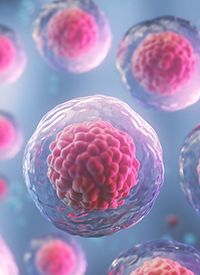News
Article
BAT8006 Elicits Disease Control, Safety in Advanced Ovarian Cancer and Other Solid Tumors
Author(s):
Treatment with the folate receptor–α antibody-drug conjugate BAT8006 led to responses with a manageable safety profile in patients with advanced solid tumors, including ovarian cancer, breast cancer, and cervical cancer.
BAT8006 in Solid Tumors | Image
Credit: © anusorn - stock.adobe.com

Treatment with the folate receptor–α (FRα) antibody-drug conjugate BAT8006 led to responses with a manageable safety profile in patients with advanced solid tumors, including ovarian cancer, breast cancer, and cervical cancer, according to data from a phase 1 trial (NCT05378737) in China.1
Findings showed that among all evaluable patients irrespective of tumor type (n = 29), the objective response rate (ORR) was 31.0%, and the disease control rate (DCR) was 86.2%. Patients with ovarian cancer who had a tumor proportion score more than 25% (n = 12) experienced an ORR of 58.3% and a DCR of 91.7%. Two partial responses were also observed in patients with breast cancer and endometrial carcinoma.
Among all patients with ovarian cancer (n = 15), approximately 75% had a FRα expression of more than 25%. Most patients with ovarian cancer received more than 3 prior antitumor therapies that included bevacizumab (Avastin) and a PARP inhibitor.
Regarding safety, the most common treatment-related adverse effects (TRAEs) included neutropenia, thrombocytopenia, anemia, nausea, and vomiting. No instances of interstitial lung disease, ocular toxicity, or severe hepatotoxicity were reported, and TRAEs did not lead to treatment discontinuation in any patients.
The trial is enrolling patients between 18 and 75 years of age with histologically or cytologically confirmed advanced or metastatic solid tumors who have progressed on or have no effective standard therapy available, or are intolerant to standard therapy or refuse standard therapy.2 Other key inclusion criteria include at least 1 measurable tumor lesion per RECIST v1.1 criteria, an ECOG performance status of 0 or 1, an expected survival of at least 12 weeks, and adequate organ and bone marrow reserve function.
Notably, FRα expression was not required for enrollment in the dose-escalation portion of the study, and it included patients with ovarian cancer, breast cancer, non–small cell lung cancer, and cervical cancer.1
During the dose-escalation portion of the study, patients were enrolled to 1 of 4 cohorts, where they received BAT8006 at doses of 1.2 mg/kg, 1.8 mg/kg, 2.1 mg/kg, or 2.4 mg/kg once every 3 weeks.1,2
The primary ends of the study are dose-limiting toxicities and to determine the maximum tolerated dose. Pharmacokinetics are a secondary end point.2
An ongoing phase 1b portion of the study is evaluating BAT8006 in 4 dose-expansion cohorts in 2 different subgroups of patients. One subgroup included patients with FRα-positive ovarian cancer, and the second consists of patients with FRα-positive non-ovarian cancers. Two different doses of BAT8006 are being evaluated in each patient subgroup.1
References
- Bio-Thera Solutions announces positive phase 1 clinical data for BAT8006 (folate-receptor-α-ADC) and presents phase 1 dose escalation study at the Bethune Obstetrics and Gynecology Forum. News release. Bio-Thera Solutions. August 13, 2023. Accessed August 14, 2023. https://www.bio-thera.com/plus/view.php?aid=883
- Evaluate the safety, tolerability and pharmacokinetic characteristics of BAT8006 for injection. ClinicalTrials.gov. Updated July 28, 2022. Accessed August 14, 2023. https://clinicaltrials.gov/study/NCT05378737








